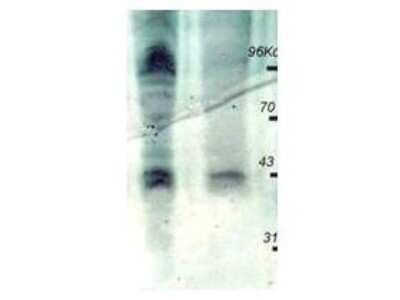Phosphothreonine Products
Phosphorylation of threonine residues is associated with many growth factors and oncogene protein kinases, and is important for cell signaling in activation, proliferation and differentiation. Protein phosphorylation and dephosphorylation are basic mechanisms for the modification of protein function in eukaryotic cells. Phosphorylation is a rare post-translational event in normal tissue, however, the abundance of phosphorylated cellular proteins increases several fold following various activation processes which are mediated through phosphotyrosine, phosphoserine or phosphothreonine (p-tyr/p-ser/p-thr). Many signal transduction pathways, such as the EGF, PDGF and insulin receptor systems, contain tyr/ser/thr kinase which phosphorylate specific tyr/ser/thr residues upon binding of ligands to their receptors. T cell antigen receptor complex or the receptors for some hemopoietic growth factors may stimulate these phosphorylation associated kinases, and cells transformed by viral oncogenes contain elevated levels of phosphorylated tyr/ser/thr. An understanding of transformation by oncogenes and mitogenic processes of growth factors depends on the identification of their substrate and a subsequent determination of how phosphorylation affects their properties. Studies on the role of phosphorylated proteins have been hampered by their low abundance and the problem of distinguishing the various types of phosphorylated proteins. The most common procedure is to label intact cells or small tissue fragments with 32P and subsequently to isolate 32P labeled proteins by conventional biochemical methods. In order to identify the specific amino acids that undergo phosphorylation, additional long and tedious procedures for phosphoamino acid analysis are required. Immunoblotting of cellular proteins with antibodies directed against phosphoamino acids is advantageous as it does not involve 32P labeling, and can therefore be employed to monitor alterations in phosphorylation of specific proteins as they occur in intact organs or the whole animal. Indeed, mono and polyclonal antibodies directed against phosphorylated residues have been generated and found useful as analytical and preparative tools because they enable the rapid identification, quantification and immunoaffinity isolation of phosphorylated cellular proteins.
Show More
7 results for "Phosphothreonine" in Products
7 results for "Phosphothreonine" in Products
Phosphothreonine Products
Phosphorylation of threonine residues is associated with many growth factors and oncogene protein kinases, and is important for cell signaling in activation, proliferation and differentiation. Protein phosphorylation and dephosphorylation are basic mechanisms for the modification of protein function in eukaryotic cells. Phosphorylation is a rare post-translational event in normal tissue, however, the abundance of phosphorylated cellular proteins increases several fold following various activation processes which are mediated through phosphotyrosine, phosphoserine or phosphothreonine (p-tyr/p-ser/p-thr). Many signal transduction pathways, such as the EGF, PDGF and insulin receptor systems, contain tyr/ser/thr kinase which phosphorylate specific tyr/ser/thr residues upon binding of ligands to their receptors. T cell antigen receptor complex or the receptors for some hemopoietic growth factors may stimulate these phosphorylation associated kinases, and cells transformed by viral oncogenes contain elevated levels of phosphorylated tyr/ser/thr. An understanding of transformation by oncogenes and mitogenic processes of growth factors depends on the identification of their substrate and a subsequent determination of how phosphorylation affects their properties. Studies on the role of phosphorylated proteins have been hampered by their low abundance and the problem of distinguishing the various types of phosphorylated proteins. The most common procedure is to label intact cells or small tissue fragments with 32P and subsequently to isolate 32P labeled proteins by conventional biochemical methods. In order to identify the specific amino acids that undergo phosphorylation, additional long and tedious procedures for phosphoamino acid analysis are required. Immunoblotting of cellular proteins with antibodies directed against phosphoamino acids is advantageous as it does not involve 32P labeling, and can therefore be employed to monitor alterations in phosphorylation of specific proteins as they occur in intact organs or the whole animal. Indeed, mono and polyclonal antibodies directed against phosphorylated residues have been generated and found useful as analytical and preparative tools because they enable the rapid identification, quantification and immunoaffinity isolation of phosphorylated cellular proteins.
Show More
Applications: WB, ELISA, ICC/IF, IP
Reactivity:
Mouse,
Non-species specific
| Reactivity: | Mouse, Non-species specific |
| Details: | Rabbit IgG Polyclonal |
| Applications: | WB, ELISA, ICC/IF, IP |
Applications: IHC, WB, ELISA, ICC/IF, Flow, ChIP, IP
Reactivity:
All Species
Recombinant Monoclonal Antibody.
| Reactivity: | All Species |
| Details: | Rabbit IgG Monoclonal Clone #RM102 |
| Applications: | IHC, WB, ELISA, ICC/IF, Flow, +2 More |
Applications: WB, ELISA
Reactivity:
Non-species specific
| Reactivity: | Non-species specific |
| Details: | Mouse IgG1 kappa Monoclonal Clone #18F6 |
| Applications: | WB, ELISA |
Applications: IHC, WB, ELISA, IP
Reactivity:
Non-species specific
| Reactivity: | Non-species specific |
| Details: | Rabbit IgG Polyclonal |
| Applications: | IHC, WB, ELISA, IP |
| Reactivity: | Human, Mouse |
| Details: | Rabbit IgG Monoclonal Clone #6K2H0 |
| Applications: | WB, ELISA |
Applications: IHC, WB, ELISA, IP
Reactivity:
Non-species specific
| Reactivity: | Non-species specific |
| Details: | Rabbit IgG Polyclonal |
| Applications: | IHC, WB, ELISA, IP |
Applications: IHC, WB, ELISA, IP
Reactivity:
Non-species specific
| Reactivity: | Non-species specific |
| Details: | Rabbit IgG Polyclonal |
| Applications: | IHC, WB, ELISA, IP |

![Western Blot: Phosphothreonine Antibody [NB110-96896] Western Blot: Phosphothreonine Antibody [NB110-96896]](https://resources.bio-techne.com/images/products/Phosphothreonine-Antibody-Western-Blot-NB110-96896-img0007.jpg)
![Western Blot: Phosphothreonine Antibody (RM102) [NBP2-77398] Western Blot: Phosphothreonine Antibody (RM102) [NBP2-77398]](https://resources.bio-techne.com/images/products/Phosphothreonine-Antibody-RM102-Western-Blot-NBP2-77398-img0002.jpg)
![Western Blot: Phosphothreonine Antibody (18F6) [NB600-878] Western Blot: Phosphothreonine Antibody (18F6) [NB600-878]](https://resources.bio-techne.com/images/products/Phosphothreonine-Antibody-18F6-Western-Blot-NB600-878-img0003.jpg)
![Western Blot: Phosphothreonine Antibody [NBP1-78035] Western Blot: Phosphothreonine Antibody [NBP1-78035]](https://resources.bio-techne.com/images/products/Phosphothreonine-Antibody-Western-Blot-NBP1-78035-img0002.jpg)
![Western Blot: Phosphothreonine Antibody (6K2H0) [NBP3-33576] - Phosphothreonine Antibody (6K2H0)](https://resources.bio-techne.com/images/products/nbp3-33576_rabbit-phosphothreonine-mab-6k2h0-912202415171146.jpg)

